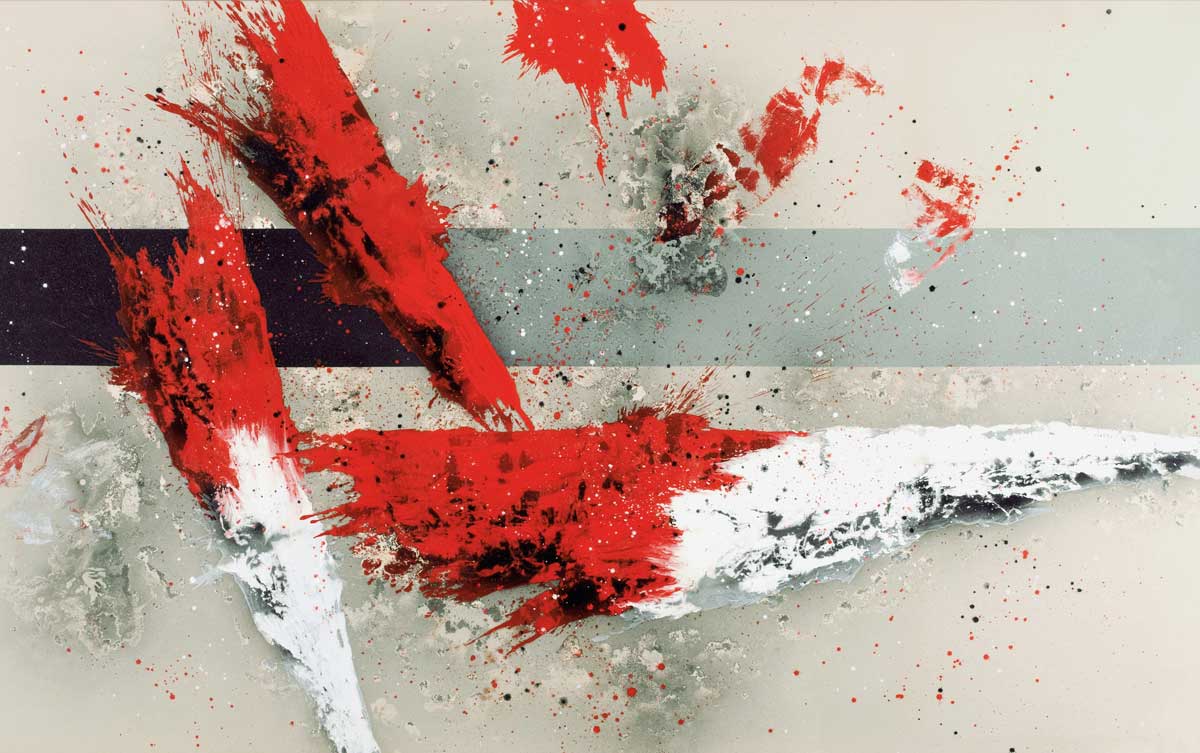
Juan Manuel Bonet. Tel Aviv.
Juan Manuel Bonet. Tel Aviv.
DETAILED PORTRAYAL OF A SPANISH PAINTER BETWEEN TWO CENTURIES
By JUAN MANUEL BONET
A Spanish painter of the Nineties, who is already spanning two centuries. A painter who, barely forty years old, has already participated in numerous exhibitions and won an equal number of awards. A brilliant painter, bursting with activity. A painter fearing neither contradiction nor paradox since he regards them as driving forces of an art he half jokingly and half seriously gathered under the motto “A.D.A.”, “Automatic Deconstructive Abstraction”, in due time.
A painter who, generally speaking, sometimes devotes himself, over his typical plastic canvas of lorries, in automatist form, to action painting. Some other times, he backs the strictest, neo-Mondrian and post-minimalist orthogonality.
An abstract painter of a generation which, still in search of its own identity, comes after that of artists like Broto, Campano, Sicilia which, in turn, followed that of Tàpies, Saura, Millares, etc.
A painter, in a time where the youth panorama abounds in non painters, the neo-conceptualists.
A painter who is able, at the same time, to paint Gesto y Orden (Gesture and Order), of turmoil and geometry, chaos and agreement. Among his most important works, I shall point out Espectador de guerras (War Watcher) (1998), thanks to the way he succeeds in reconciling seemingly irreconcilable concepts. It is a painting made of white cascades and having at the same time a non significant and classic presence. Displayed the same year it was painted, at the first one-man exhibition of Ciria, held at the Art Gallery Salvador Díaz in Madrid, such picture was bought by the Contemporary Art Institute of Valencia (IVAM) I was in charge of as Manager at that time.
A painter of cascades, of Piel de agua (Water skin) and Glosa líquida (Liquid gloss) and, at the same time, a painter of wefts and grids.
A painter of white, ochre, red, orange, black and, above all, grey hues. Grey is the colour of a large part of the Spanish tradition, from Zurbarán to Tàpies, going through Juan Gris –a suitably well-chosen pseudonym1–, Luis Fernández or Gerardo Rueda.
An abstract painter, as I have already said, who, when the moment came, has not avoided dialoguing with reality as can be seen in his series about Extremadura, Monfragüe, made of “abstract emblems over the landscape” or in some of the works he painted during his stay at the Spanish Academy in Rome.
A painter regarding the principle of collage as essential, a technique that enabled him, in several occasions, to widen the horizon of his work, to flee the temptation of repetition as well as to transform his intimate diary in a monument.
A painter with memory, able to allude, in an abstract painting, to a tricycle of his childhood he spent, as a Spanish kid, in Manchester, or in several of his huge and impressive collages, we could call river-collages, as we speak in terms of river-novels, to the par excellence chaotic kids room, of which he has directly poured some of its contents over the painting surface.
A curious and voracious painter, harbouring a memory of the history of his discipline and who has always taken an interest, as passionate as he can be, in the painting of past times. This stands out quite clearly in his tributes to Giotto, to Zurbarán mentioned earlier –La sombra de Zurbarán o toda la tradición española (1997) (Zurbarán’s shadow or the whole of Spanish tradition)–, to the brightest Monet, Matisse, Malevich, Pollock –from time to time, Ciria also makes use of dripping–, or Motherwell, the most European of all the North-American painters of the great generation.
A true painter who, in due time, also paid tribute to Joseph Beuys and who, if need be, does not hesitate to stand behind the camera, as he has just done for his latest large-size paintings, whose supports are huge photos of naked models.
A painter who is also a magnificent engraver. Early this year, the Museum of Spanish Engraving of Marbella awarded him one of the most important prizes of this discipline in Spain.
A painter stating that “you always paint the same picture”, who really masters an especially personal technique and who, at the same time, does not fear to bewilder everybody, convinced as he is that contradiction and paradox, I referred to earlier, are advantageous for an artist.
An already well-known painter in Spain who has also successfully approached the international panorama: Germany, Japan, Italy, USA, Israel, etc.
A painter to keep an eye on. No doubt about it.
